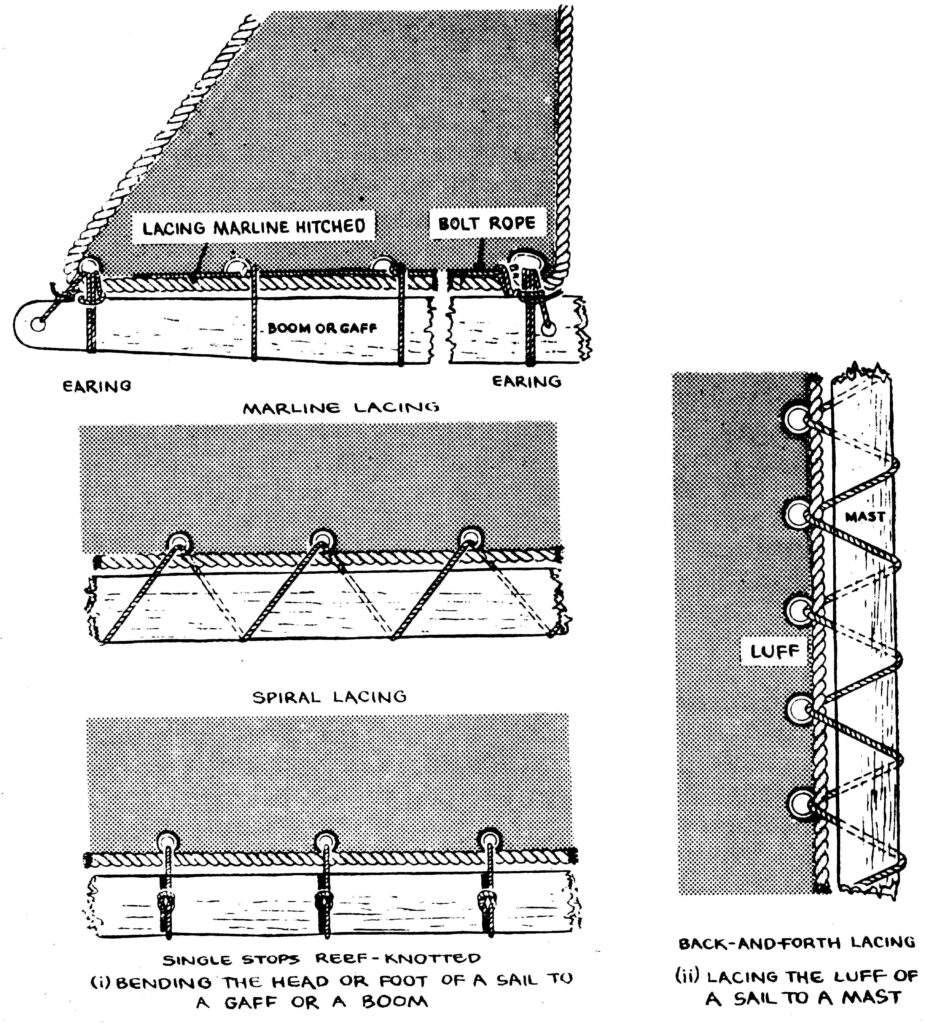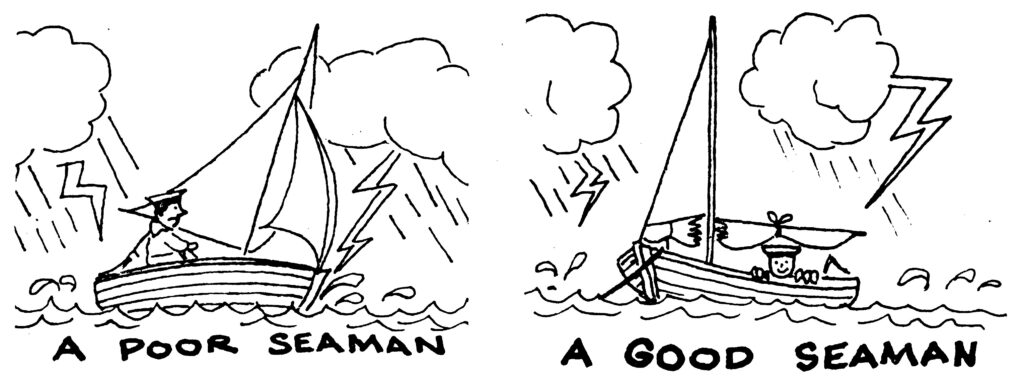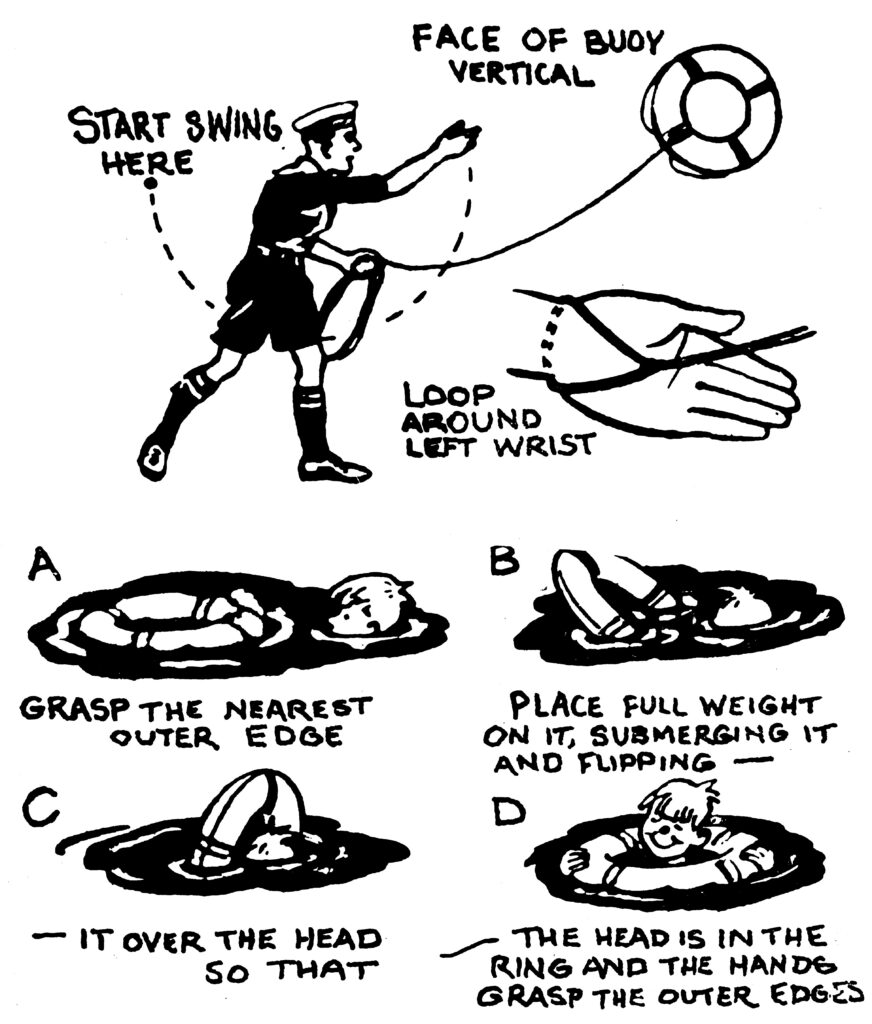Boat Sailing
Sailing Rig of a Standard Boat
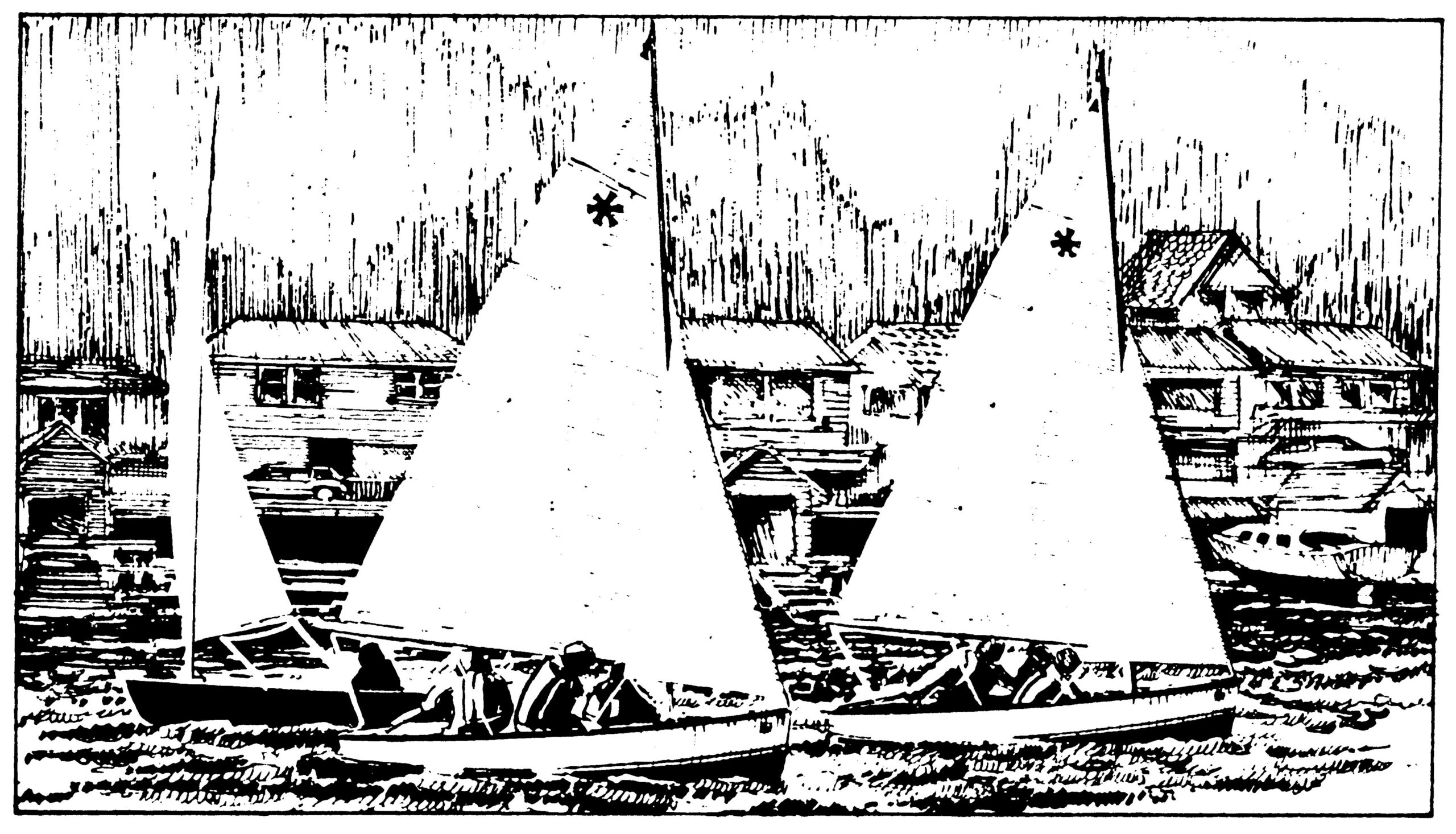 The Standard boat is “Sloop” rigged; that is to say, it has a single mast carrying one headsail, called a foresail, and one mainsail. The mainsail is Gunter rigged, a compromise between Bermuda and Gaff rigs.
The Standard boat is “Sloop” rigged; that is to say, it has a single mast carrying one headsail, called a foresail, and one mainsail. The mainsail is Gunter rigged, a compromise between Bermuda and Gaff rigs.
This rig means that while the sail is cut to almost the same shape as Bermuda sails, the top half of the luff, or the head of the sail, is secured to a gaff, which is hauled close up to the mast and serves as an extension to it. It is particularly suited to the Standard boat because of the desirability of having a mast which can be stowed inside the boat.
The sails are usually made of terylene, a hard-wearing light fabric which lasts longer than cotton or canvas.
Sails and Rigging
The parts of three and four-sided sails are named in the accompanying illustration of a Standard boat. The details are common to most fore-and-aft rigged boats.
Additional information about boat sails and rigging follows: A bolt rope is the roping on the edge of a sail. It is always sewn on the side of the sail which will be to port when the sail is set. The luff, head and foot of a Standard mainsail are roped.
A sheet is a rope bent to the clew of a sail by which the sail is trimmed as required and is named after the sail to which it is bent, i.e., fore-sheet, mainsheet. To check a sheet is to ease it away so that the sail is eased out. To aft a sheet is to haul it in so that the clew of the sail is hauled aft, and to “let fly” a sheet is to let it run so the sail flaps and the wind is spilled out of it.
A halyard is a rope by which a sail is hoisted and lowered, and to “settle” a halyard is to ease it away.
Cringles are eyes worked into the bolt rope at the sides and corners of the sail and to which are bent the halyards, sheets and tack hook, in the case of a Standard foresail, and the peak, throat, tack, and clew earings of the Standard mainsail. Two extra cringles are fitted at the end of the line of reef points on the mainsail, and these become the tack and clew when a reef has been taken in.
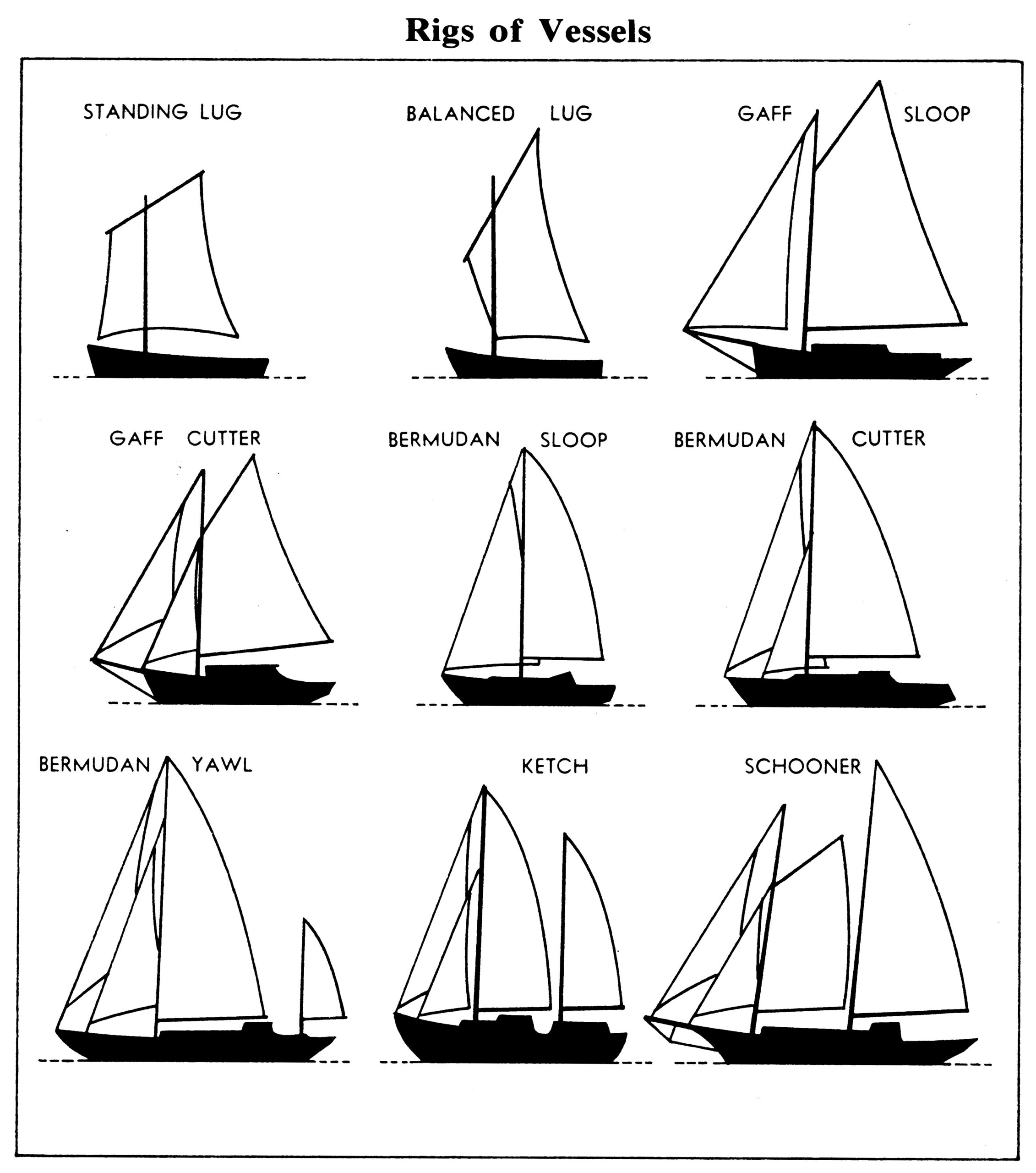
Eyelets are eyes worked into the head, luff, and foot of the sail for lacing it to a spar.
An earing is the lashing which secures the throat, peak, clew or tack of a sail to its spar.
Yard and gaff. The head of a four-sided sail is bent to and supported by either a yard or a gaff—a yard crosses the mast, but a gaff has jaws at its throat which fit around the mast.
Reef points are short lengths of line secured to each side of a sail in pairs, above its foot, and are used for reefing the sail. To “reef” a sail is to reduce its area to prevent heeling too far over and capsizing. A Standard is reefed by settling the halyard until the reef points can be secured round the foot of the sail. “Taking down a reef” is putting a reef in a sail and “shaking out a reef” is to take it out again.
The foresail is the sail set before the mast. (NOTE: The Standard headsail is a foresail, not a jib. A jib is any headsail set before the foresail.)
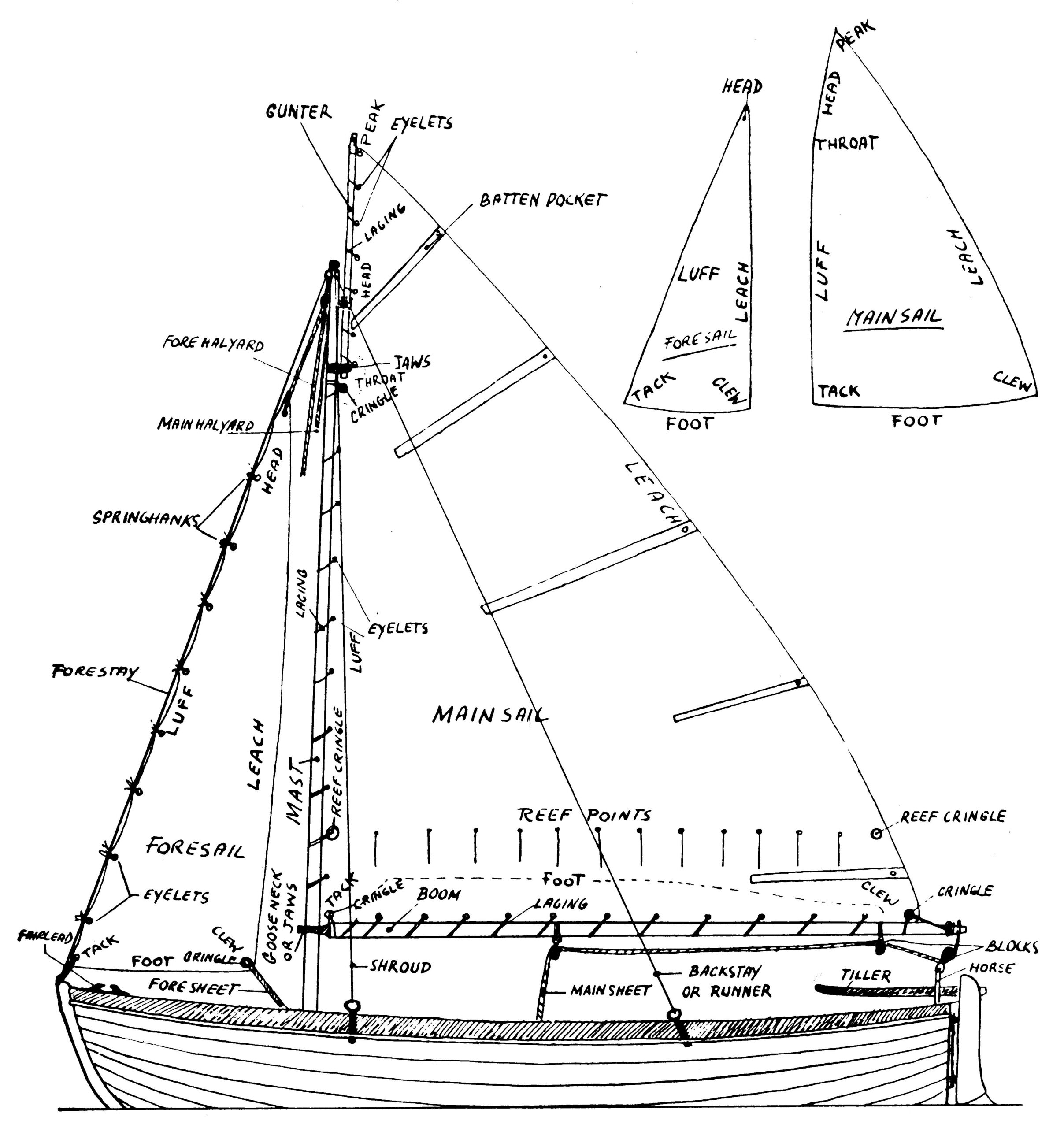
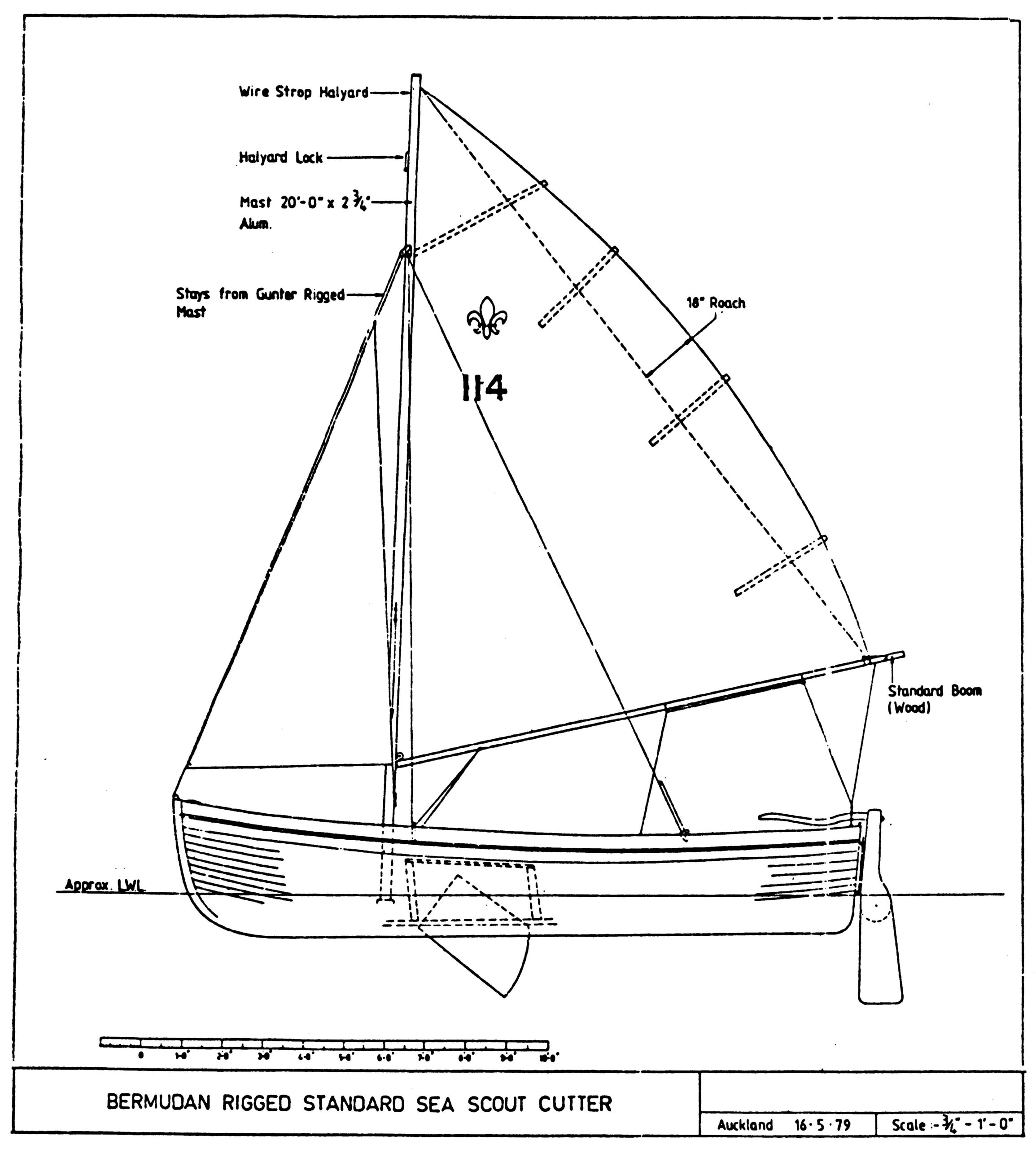
STANDARD SCOUT CUTTER ALTERNATE
Mast | Aluminium extrusion with continuous luff groove to the following dimensions: Length: 6100 mm (20′-0″) Cross Section: 77 x 63 mm. minimum No buoyancy to be added. A 16 mm diameter hole to be drilled in the base for drainage. |
Goose Neck | Either fixed or adjustable —Material: Stainless Steel |
Halyard | Two locks to be fitted to mast so that main sail can either be fully hoisted or lowered to reef point. |
Boom | Either original wood or aluminium. Aluminium extrusion with continuous foot groove. Length: 3860 mm (12′-8 Cross Section: 63 x 57 mm minimum. |
Boom Vang | Own choice. |
Sails: Jib | Foot: 1651 mm (5′-5 Luff: 3530 mm (11 ‘-7″) Leach: 3251 mm (10′-8″) |
Main sail | Foot: 3632 mm (11 ‘ -11″) Luff: 4699 mm (15′-5 Leach: 5410 mm (17′-9″) Leach Roach: 457 mm (1 ‘-6″) 1 Reef Point: 914 mm (3 ‘-0″) Either slab or reef points at 3′ up luff. |
N.B. If aluminium boom is used then foot of main sail requires bolt rope sewn in.
A trisail has been designed for the Standard. It is a triangular, loose-footed sail set in place of the mainsail.
A forestay leads forward from the masthead and is secured either to a stemhead shackle or a chainplate on the stemhead.
Shrouds lead from the masthead to chain plates on the sides of the boat and support the mast athwartships.
Backstays, commonly called “runners”, lead aft from the masthead to support the mast, particularly when sailing with the wind abaft the beam.
Standing rigging comprises all the permanently fitted and secured wires such as stays and shrouds. In a Standard these are made from 20 mm steel wire rope with served hard eyes each end and are shackled to the masthead spiderband with Dshackles. Nowadays stainless steel wire with talurit splices are used for the stays. The lower ends are fitted with lanyards, usually a nylon cord.
Running rigging comprises all the movable ropes such as sheets and halyards. Made from 30 mm rope in Standards, usually nylon.
Rigging a Standard
Stow the oars under the thwarts, blades aft, two each side of the centre case on the bottom boards.
Place the mast in the boat, heel forward, and the mainsail on its spars alongside the mast, peak aft.
Step the mast through its bracket into the mast step and secure the forestay and shrouds, taking care to evenly divide the strain. Set up the runners (if fitted) and leave them slack.
Bend the foresail halyard to the peak of the foresail, and attach the clips on the luff of the foresail to the forestay. The tack of the foresail should be secured to the stemhead chainplate by a shackle or lanyard so that the foot of the foresail when set will be approximately the same height as the foot of the mainsail.
Secure the foresheet leading blocks to the shroud chainplate and reeve the sheets (put a stopper knot, such as a figure of eight, in the ends of the sheets to prevent them unreeving), leave the foresail lowered and belay the end of the halyard to the cleat on the starboard side of the mast.
Secure the main halyard to the gaff with a rolling hitch (with the two turns toward the peak), and make sure the knot is so made that the halyard leads fairly into the masthead sheave, otherwise the gaff will twist and upset the set of the sail.
Check that the peak and clew earings have been hauled taut and secured. (This should be done ashore before the sail is placed in the boat.)
Hoist the sail, passing back and forth lacing from the luff round the mast.
Fit the battens and secure them in their pockets, with the exception of the bottom batten unless it is intended to leave the sail hoisted.
Pass the eye of the mainsheet over the outboard end of the boom, then reeve the sheet through the single block on the horse, then through the block at the end of the boom and forward through the leading block above the stroke thwart and coil down on the bottom boards.
The tack of the mainsail is secured by a short tack line if the boom is fitted with jaws. The tack line prevents the boom from riding up the mast and keeps the luff taut. Larger vessels have a tack tackle. There is no tackline if the boom is secured by a gooseneck swivel.
When the sail is fully hoisted the boom should be about a foot above the gunwale and the gaff close up to the mast with no slacking away at the peak.
The halyard should then be belayed to the cleat on the forward side of the mast. Always use this cleat for the main halyard, and the cleat on the starboard side of the mast for the foresail; then there can be no mistakes among the crew if a halyard is required in a hurry.
Some boats have tracks fitted to the mast and runners or slides sewn on the luff. They are a very satisfactory alternative to lacings, but care must be taken when handling the mast to avoid damaging the track, thus causing the slides to jam.
Fit the sailing tiller in the rudder head and secure it with its pin. Lower the centre-plate.
Sailing Terms
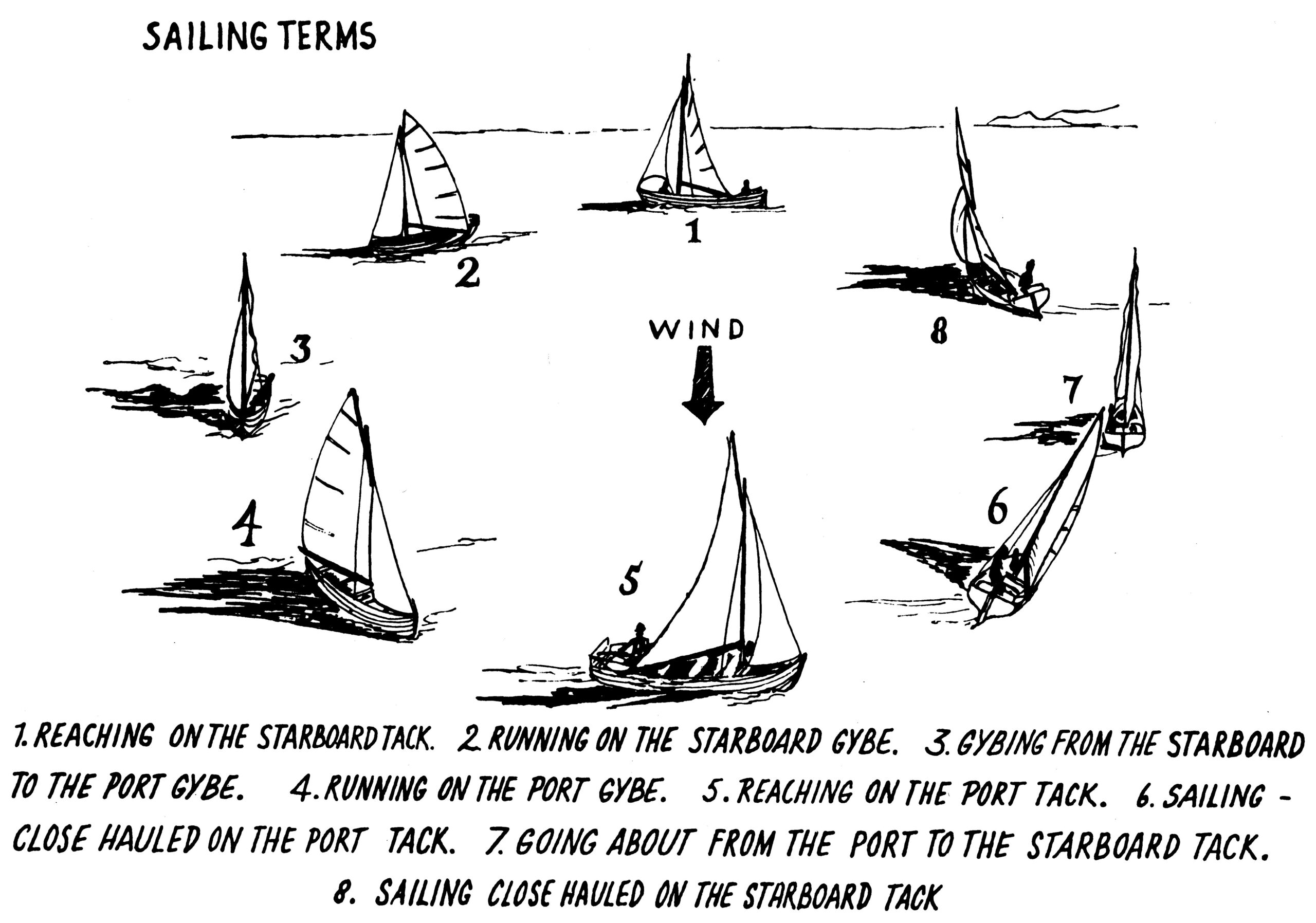
Close-hauled: A boat is “close-hauled” when all the sails are drawing, and it is sailing as close as possible to the direction from which the wind is blowing.
Sailing Free: A boat is sailing free whenever the sails are filled and it is not sailing close-hauled, i.e., when it is free to manoeuvre freely on either side of its course without having to go about.
Reaching: A boat is reaching when it is sailing free, with the wind abeam or a little before the beam.
Running: A boat is running when sailing with the abaft the beam
Port and Starboard Tacks: When either close-hauled or reaching a boat is on the “port tack” when it has the wind on the port side and the “starboard tack” when it has the wind on the starboard side.
Beating: When a boat works close-hauled to windward in a series of tacks it is said to be beating.
Wearing: A boat “wears” when it changes from one tack to another, stern to wind, i.e., opposite to tacking.
Gybes and Gybing: As the boat’s stern passes through the wind when wearing, the mainsail will be blown from one side to the other and the boat is then said to “gybe”. When running with the wind on the starboard quarter the boat is said to be on the “starboard gybe” and with the wind on the port quarter it is said to be the “port gybe”.
A boat running before the wind “gybes” when either purposely or accidently the mainsail is blown across to the opposite side of the boat.
To Miss Stays: A boat “misses stays” when it fails to go about from one tack to the other and pays off on the original tack.
In Irons: A boat is “in irons” when it fails to go about from one tack to another and lies head to wind unable to pay off on either tack. It is then necessary to “back the foresail” and check the mainsail to get it to pay off on to the new tack. If it gathers sternway it is necessary to put the helm over to the opposite side.
The Helm: The coxswain always sits to windward of the tiller. “Up helm” or “Bear up” are orders to the coxswain to move the tiller up to windward and the bows will pay off from the wind. “Down helm” is an order to the coxswain to push the tiller to leeward and the bows will turn toward the wind. “Weather helm” is when a boat tends to come up into the wind even with the helm held amidships, and “Lee helm” is when the boat tends to pay off with the helm amidships. Most Standards carry a weather helm.
To “weather” an object such as a buoy is to pass on the windward side of it.
To “luff” is to bring the boat’s bow closer to the wind.
To “back a sail” is to trim it so as to catch the wind on its fore side (i.e., back the foresail).
To “heave to” is to lie close to the wind and stopped, by backing the foresail.
To “hug the wind” is to sail as close to it as possible.
To “pinch” is to hug the wind too closely so that the luff flaps and the sails are not properly filled.
To “set” or “make sail” is to hoist sails and get under way.
To “goose wing” is to set the foresail and the mainsail on opposite sides when running before the wind.
Sailing a Standard
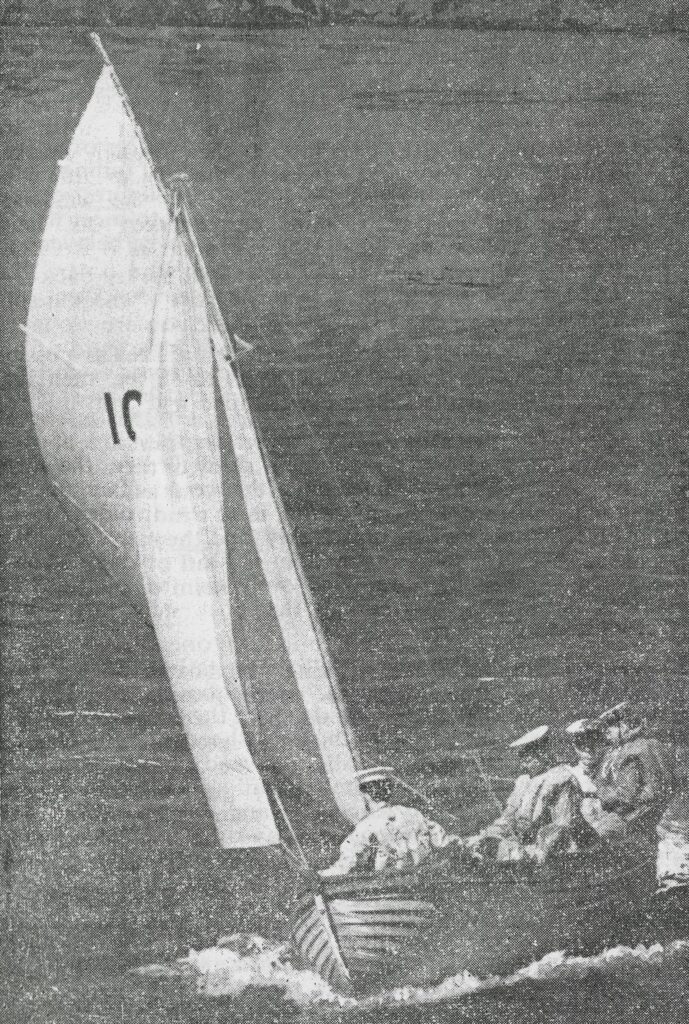 Having got our boat rigged and a fair idea of the terms and orders used, we are ready to set sail. The set of the sails is almost as important as their trim and the chief factor in setting sail is to see that the luff is hauled up taut. The position of the halyard in the gaff is all-important if the sail is to set correctly and, once found, so that the sail is the correct height above the gunwale and the gaff hard up to the mast, it should be clearly marked. The correct lead of the foresheets is also important. There should be a sufficiently wide gap between the leach of the foresail and the luff of the mainsail for the wind to flow freely between them. When correctly led the sheet should approximately bisect the angle of the clew, and the pull of the sheet should tend to tauten the leach rather than the foot. The mainsail is cut to set in a slight curve whose greatest depth is just abaft the luff.
Having got our boat rigged and a fair idea of the terms and orders used, we are ready to set sail. The set of the sails is almost as important as their trim and the chief factor in setting sail is to see that the luff is hauled up taut. The position of the halyard in the gaff is all-important if the sail is to set correctly and, once found, so that the sail is the correct height above the gunwale and the gaff hard up to the mast, it should be clearly marked. The correct lead of the foresheets is also important. There should be a sufficiently wide gap between the leach of the foresail and the luff of the mainsail for the wind to flow freely between them. When correctly led the sheet should approximately bisect the angle of the clew, and the pull of the sheet should tend to tauten the leach rather than the foot. The mainsail is cut to set in a slight curve whose greatest depth is just abaft the luff.
Trimming the Sails: The strength and direction of even a steady wind is continuously altering and the art of sailing a boat lies mainly in paying constant attention to its slightest change and then altering course or trimming the sails to meet it. The sheets should always be kept in hand and never belayed.
Getting Under Way: With the sails set and the lee back-stay slack, order the bows to “bear off”, the “aft fore” , “check main”, and the boat will pay off on to the wind. If you are alongside a jetty and can hang on aft until the bows have paid off, so much the better. As soon as the bows have come round “aft main”, then pay attention to the trim of the sails and shift the crew to balance the wind and keep the boat upright. Sailing the boat along with the lee gunwale nearly awash may look fun, but a lot of the wind will be spilling off the top of the sails instead of driving the boat along. Keep a curve in your sails — they can be set flatter in a high wind than in a light wind. When sailing on the wind, as when beating, the luffs of the sails should be just not shivering, so keep an eye on the luff of the mainsail, and if it starts to shiver ease up on the helm until the sail is steady.
Going About: Before going about from one tack to another the boat should be paid off a little so as to gather way to enable it to get round; the coxswain calls “Ready about”, ease the helm down gently, and the boat sails through the wind to opposite tack. As the helm is put down the mainsheet should be hauled aft and the foresail checked slightly, and as the bows pass through the eye of the wind the foresail should be backed by hauling aft the windward foresheet, and the mainsail should be checked; this helps the boat to pay off on the other tack. As soon as it is certain that the bows will pay off on the new tack, the order, “Let draw, aft sheets,” should be given, the lee foresheet and the mainsheet being hauled aft.
When reaching keep the boat on as even a keel as possible and check the sheets until the sails start to shiver, then haul them in a little until the sails are well filled and taut.
When running the sails should be set so they are at right angles to the wind. When running dead before the wind the sails may be goose-winged and the centre-plate up, but running dead before a strong wind is to be avoided as the boat will tend to yaw uncontrollably and may gybe, broach to and capsize. If your destination is down wind, steer a zig-zag course, keeping the wind well on the quarter. No time will be lost doing this as the boat sails faster with the wind on the quarter.
Wearing is the reverse of tacking, the boat changing from one tack to the other, with the stern passing through the wind. To wear, the helm should be eased up gently and the mainsheet hauled aft as the helm is eased up, and checked quickly as soon as the wind is on the other side of the sail. It is important to avoid gybing the boat heavily because the weight of the boom swinging over may carry away the shrouds or backstays and heel the boat over before the crew have a chance to trim it on the new tack, in which case it may capsize.
Rough Weather: When struck by a squall the sheets should be quickly checked, particularly the foresail, and the helm eased down to luff the boat up and spill the wind from the sails; the sheets can then be hauled aft, and the boat paid off as necessary to continue on the original course.
Reefing: Take in a reef as soon as the boat starts to get “wet”, that is, when the water starts to splash in over the lee gunwale. Luff the boat up into the wind, take out the bottom sail batten and lower the main halyard so that the sail when reefed will set at the correct height above the gunwale. Tie the reef cringle earings around the boom, mast end first; then tie the reef points round the foot of the sail, gathering the sail neatly. To shake out a reef reverse this procedure, i.e., luff up and spill the wind from the sail, untie the reef points, let go the reef earings, then haul taut on the main halyard and replace the bottom sail batten.
Capsizing: In the event of a capsize instruct the crew to stay with the boat. If possible the standing and running rigging should be cast off or cut off, the sails, spars and rigging hauled clear, the drop keel raised, and the mast unshipped and secured to the sails and spars and allowed to float clear of the boat but secured by a line. Whenever possible a swamped sailing boat should be unrigged, and the mast unshipped before it is taken in tow.
With buoyancy fitted in the boat it may if weather conditions permit be possible to recover the boat. By righting, lowering the sails and getting one Scout in to start bailing for all he is worth, with a large bailer.
Going Alongside: Always go alongside head to wind if possible, approach the landing place on a reach, checking the sheets to control the speed. Order the bowhand to stand by and at the same time order the fenders out. Haul the sheets aft as you ease the helm down to round up into the wind and “let fly” when you judge the boat to have sufficient way on to come exactly alongside without bumping. Remember that a heavily laden boat will carry her way much further than a lightly laden one.
Crew Overboard: If a member of the crew falls overboard, immediately throw the lifebuoy, then detail one of the crew to keep their eyes on them. If you are beating or reaching, wear your boat round so as to bring it to leeward of the person, then you can approach them close-hauled and luff up alongside them. If you are running you must run on for a bit, then bring your boat round close-hauled on the same tack and then go about, so that you will come up just to leeward of the person and so able to luff up alongside them. In either case the boat must be nearly stopped as you come alongside them, or the crew will not be able to hold on to them.
Sailing art which requires practice to develop skilled coxswains. Get out as often as you can and try out these instructions in handling.
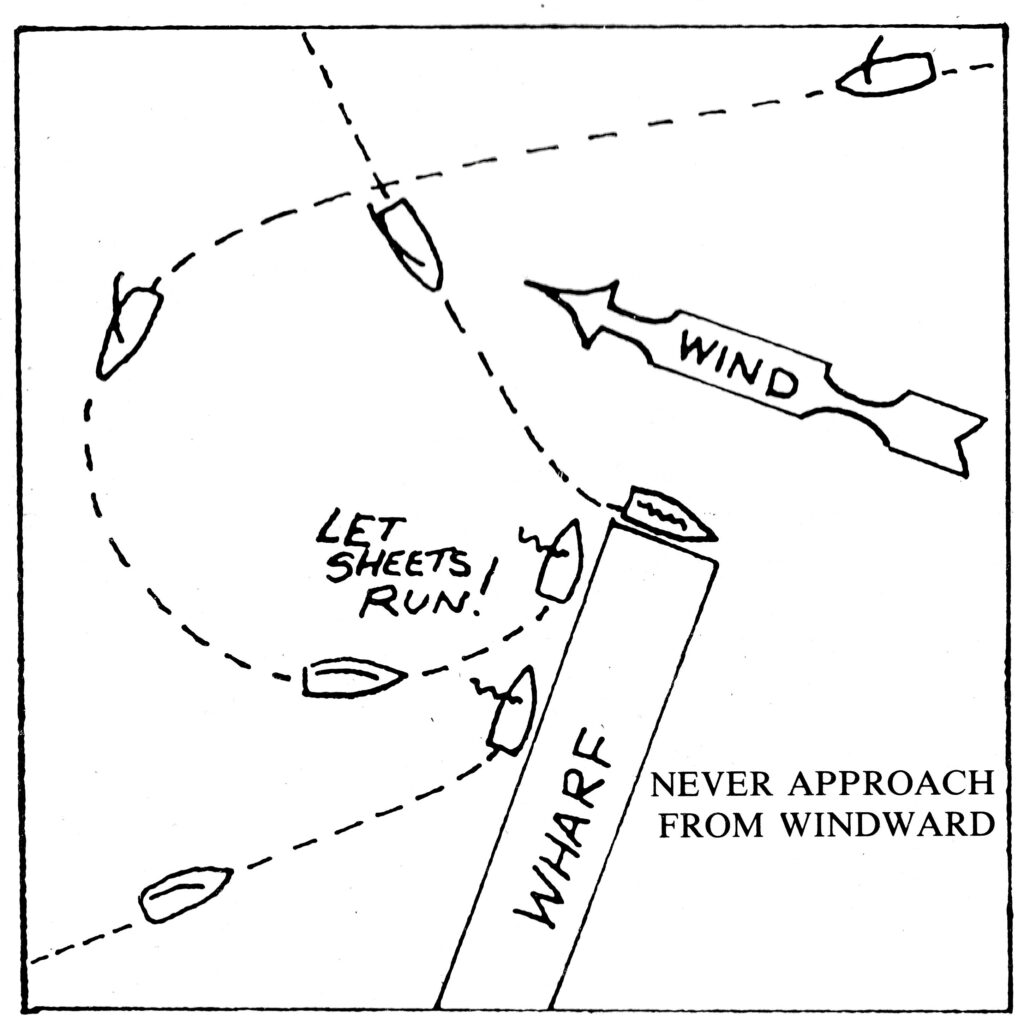
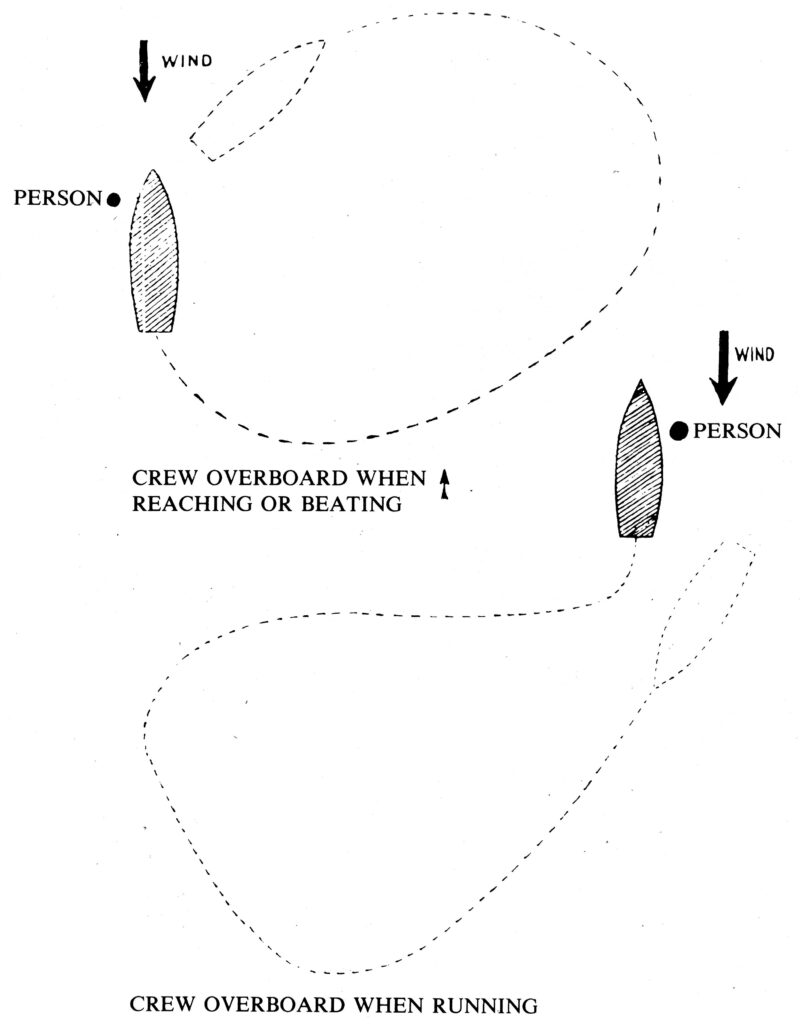
Boat’s Sails
Care of the Sails
Boat’s sails must always be carefully handled and properly maintained, otherwise they will not set correctly and will lose their effectiveness, cotton and canvas sails stretch when new, terylene does not stretch.
The best method of stretching new sails is to sail with them on a sunny day in a light breeze, but the following precautions must be observed:
Do not set up the halyards or tack line too taut, otherwise the luff may be stretched more than the leach.
Do not haul the sheets flat aft because this may distort the clew or stretch the leach.
Constantly take up any slack in the head and foot with the peak and clew earings.
Keep the sails dry and do not reef until the sails are fully stretched, and, if the sail should get wet, settle the halyard and ease away the peak and clew earings.
Do not stow sails away with metal fittings or wet sheets. During the winter sails should be unbent from the spars for stowage in a locker in which the air can circulate freely. During the boating season ease away the peak and clew earings before stowing the sails away. When this has been done lay the gaff on the boom, then gather the bight up underneath. The last of the bight should then be rolled up round both spars.
No sail should be stowed away wet; if wet from salt water it should be rinsed in fresh water, then dried before being stowed.
Dirty sails can be washed in fresh water with soap and, if necessary, very lightly scrubbed.
To Bend a Sail to a Spar
The head of a mainsail is bent to the gaff by peak and throat earings and a lacing; the throat earing is the fixed anchorage and the peak the movable one.
The foot of the mainsail is bent to the boom by tack and clew earings and a lacing; the tack earing is the fixed anchorage.
The sail may be laced to the spar by any one of the three methods illustrated, lacing from the throat or tack towards the peak or clew.
The spiral lacing is the best for light sails because it allows the head and foot to take up a natural set along the spar. Heavier sails are usually marled to their spars or secured by single stops.
The luff of the mainsails is laced to the mast by the back and forth lacing shown in the illustration. If the lacing is passed spirally it tends to jam when the sail is hoisted or lowered.
